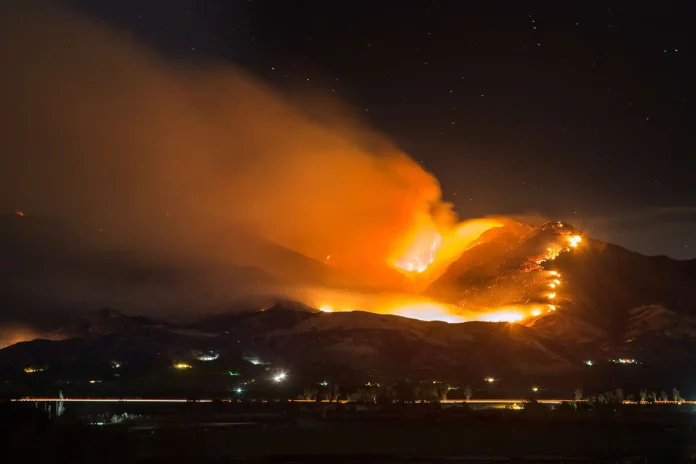The Santa Ana Winds and climate change is a natural meteorological phenomena, peculiar to Southern California, that have been popular for their tendency to develop wildfires. However, the intensity and frequency of these fires in the recent past has been enhanced by climate change leading to fire risk being a problem all year round rather than seasonally. Apart from facilitating the escalation of fires at ingenious speeds, these hot, dry winds point to how fragile ecosystems and communities are in a warming world. In this article, we shall raise awareness on how dangerous the combination of Climate Change and Santa Ana winds works and what kind of disaster it brings.
What Are the Santa Ana Winds?
Santa Ana Winds is a hot and dry wind that blows from the east across the prevailing coastal mountain range to the South of California. These winds are developed when winds blowing from high terrain pressure in the Great Basin are forced down through passes and canyons. When the air falls it has to get thicker, warm and dry so as to produce the gusty, hot Santa Ana Winds we know today.
Key characteristics of Santa Ana Winds include:
High Speeds
Winds can be as strong as 100 mph.
Dry Air
Relative conditions decrease drastically, making them highly susceptible for explosion.
Seasonal Timing
Usual during the fall and winter season though has been observed to be either seasonal or produced throughout the year most especially because of global warming.
The Role of Climate Change in Amplifying Wildfires
Hotter, Drier Conditions
Extreme weather has made drought and heat waves worse and these have escalated destruction of vegetation and provision of a ready source of fuel for calamitous fires. California has faced some of its hottest years on record over the past decade; it has not received significant amounts of rain to help revive the area. This means that when Santa Ana Winds arrive they combine with highly inflammable conditions therefore resulting in the wildfire.
Year-Round Fire Season
Historically, California wildfire is chiefly limited to summer and early autumn segments throughout the year. Today, however, because of climate change, fire dangers are present all year round. Extended heat with climate change inducing inconsistencies in the rainfall patterns has made the term ‘fire season’ synonymous with a virtual all year round occurrence. According to the words of California Governor Gavin Newsom, there is no fire season. It’s been a year of fire.
Frequency and intensity of winds increase
Consequently, literature indicates that climate change might affect the occurrence of the Santa Ana Winds and the degree to its impact on California. Higher temperatures also call for increased high pressure strengths that increase wind speed and enhance the chances of drier vegetation.
The Recent Wildfires: A Case Study
The recent disasters, which occurred in the regions of Los Angeles, feature examples of the disastrous Santa Ana Winds and climate change. These fires:
Scorched Over 23,000 Hectares
The fires quickly got out of control because of wind and burned more than 12,000 structures and displacing hundreds of thousands of people.
Killed At Least 24 People
Lightning-caused fires especially in combination with wind-blown fires have the problem that escape routes are difficult to access.
Highlighted Climate Vulnerability
The fire experts pointed out that droughts resulting from climate change as well as high temperatures were ideal for such huge fires.
The Science Behind Santa Ana Winds and Climate Change
Let’s discuss science behind the this experience:
How Santa Ana Winds Form
Santa Ana Winds develop from high-pressure systems over the great Basin. It rises and cools as it goes up the mountains and then it falls through the gaps to be compressed and heated in the process, therefore turns wet. The process is what gives rise to the dry warm winds that are experienced in the course of the phenomenon.
Climate Change’s Influence on Wind Patterns
As for climate change and wind influences, there is still debate about it, but some arguments imply that the warming process is likely to increase intensity of high pressure, and therefore increase wind forces. Further, the variation in characteristics of precipitation and snowpacks in the Great Basin may well affect the frequency and timing of these winds during the seasonal year.
Synergistic Effects with Climate Change
The interaction between the Santa Ana Winds and climate change is particularly destructive because:
Droughts and Heat Waves
These dry out vegetation and therefore become more prone to combustion than any other type of fuel.
Increased Fuel Load
Low humidity and absence of freezing temperatures promote the formation of dry and dry plant residues.
Longer Burning Seasons
While in the past, such fires are seasonal, ending during wintertime – at present, the fires are extended seasonally due to drought-type climatic variations.
The Broader Impacts of Santa Ana Winds and Wildfires
The devastating effects of wildfires go beyond immediate destruction:
Human Health
Smoke and air pollution from wildfires affect respiratory as well as the cardiovascular system.
Economic Costs
Restoration and construction, fire fighting equipment, and claims for losses amount to billions of dollars each year.
Biodiversity Loss
Wildfires result in destruction of living spaces; endangered species are affected, and ecosystems are tampered with.
Climate Feedback Loops
Wildfires emit large quantities of carbon dioxide gas which adds to the greenhouse effect and other rising vices.
Mitigating the Impact of Santa Ana Winds and Climate Change
Let;s discuss some mitigating measures of this change:
Policy and Infrastructure
Homes and infrastructure should be designed to withstand high winds and fire.
Enhanced training, equipment, and technology are crucial for combating wildfires.
Climate Action
Transitioning to renewable energy and implementing sustainable practices can slow the progression of climate change. Restoring ecosystems and managing vegetation can reduce fire risks.
Community Preparedness
Clear communication and well-practiced evacuation procedures can save lives. Educating residents about fire risks and prevention measures is critical.
Climate change has also made what was once a seasonal condition causing miracle winds blowing across the Santa Ana Mountains a year-round occurrence. Combined with heat, prolonged droughts, and arid environment, it becomes clear that climate change should not be ignored anymore due to these weather forecasters’ ability to fuel wildfires. To deal with both the specific meteorological phenomenon and with climate change, we need to pursue a two-pronged strategy of emission reduction and sustainable land management and adaptation planning. It is only through a concerted push that one is likely to reduce the calamitous impact of this perfect storm.



